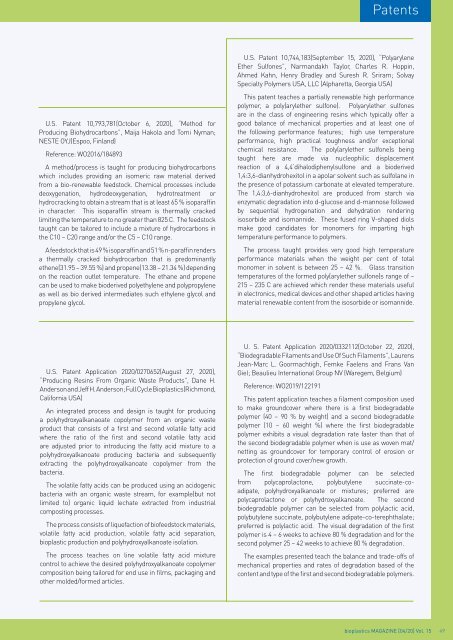Issue 06/2020
Highlights: Films / Flexibles Bioplastics from waste-streams Basics: Eutrophication
Highlights:
Films / Flexibles
Bioplastics from waste-streams
Basics: Eutrophication
You also want an ePaper? Increase the reach of your titles
YUMPU automatically turns print PDFs into web optimized ePapers that Google loves.
Patents<br />
U.S. Patent 10,744,183(September 15, <strong>2020</strong>), “Polyarylene<br />
Ether Sulfones”, Narmandakh Taylor, Charles R. Hoppin,<br />
Ahmed Kahn, Henry Bradley and Suresh R. Sriram; Solvay<br />
Specialty Polymers USA, LLC (Alpharetta, Georgia USA)<br />
U.S. Patent 10,793,781(October 6, <strong>2020</strong>), “Method for<br />
Producing Biohydrocarbons”, Maija Hakola and Tomi Nyman;<br />
NESTE OYJ(Espoo, Finland)<br />
Reference: WO2016/184893<br />
A method/process is taught for producing biohydrocarbons<br />
which includes providing an isomeric raw material derived<br />
from a bio-renewable feedstock. Chemical processes include<br />
deoxygenation, hydrodeoxygenation, hydrotreatment or<br />
hydrocracking to obtain a stream that is at least 65 % isoparaffin<br />
in character. This isoparaffin stream is thermally cracked<br />
limiting the temperature to no greater than 825 C. The feedstock<br />
taught can be tailored to include a mixture of hydrocarbons in<br />
the C10 – C20 range and/or the C5 – C10 range.<br />
A feedstock that is 49 % isoparaffin and 51 % n-paraffin renders<br />
a thermally cracked biohydrocarbon that is predominantly<br />
ethene(31.95 – 39.55 %) and propene(13.38 – 21.34 %) depending<br />
on the reaction outlet temperature. The ethane and propene<br />
can be used to make bioderived polyethylene and polypropylene<br />
as well as bio derived intermediates such ethylene glycol and<br />
propylene glycol.<br />
This patent teaches a partially renewable high performance<br />
polymer, a poly(arylether sulfone). Polyarylether sulfones<br />
are in the class of engineering resins which typically offer a<br />
good balance of mechanical properties and at least one of<br />
the following performance features; high use temperature<br />
performance, high practical toughness and/or exceptional<br />
chemical resistance. The poly(arylether sulfone)s being<br />
taught here are made via nucleophilic displacement<br />
reaction of a 4,4’dihalodiphenylsulfone and a bioderived<br />
1,4:3,6-dianhydrohexitol in a apolar solvent such as sulfolane in<br />
the presence of potassium carbonate at elevated temperature.<br />
The 1,4:3,6-dianhydrohexitol are produced from starch via<br />
enzymatic degradation into d-glucose and d-mannose followed<br />
by sequential hydrogenation and dehydration rendering<br />
isosorbide and isomannide. These fused ring V-shaped diols<br />
make good candidates for monomers for imparting high<br />
temperature performance to polymers.<br />
The process taught provides very good high temperature<br />
performance materials when the weight per cent of total<br />
monomer in solvent is between 25 – 42 %. Glass transition<br />
temperatures of the formed poly(arylether sulfone)s range of ~<br />
215 – 235 C are achieved which render these materials useful<br />
in electronics, medical devices and other shaped articles having<br />
material renewable content from the isosorbide or isomannide.<br />
U.S. Patent Application <strong>2020</strong>/027<strong>06</strong>52(August 27, <strong>2020</strong>),<br />
“Producing Resins From Organic Waste Products”, Dane H.<br />
Anderson and Jeff H. Anderson; Full Cycle Bioplastics(Richmond,<br />
California USA)<br />
An integrated process and design is taught for producing<br />
a polyhydroxyalkanaoate copolymer from an organic waste<br />
product that consists of a first and second volatile fatty acid<br />
where the ratio of the first and second volatile fatty acid<br />
are adjusted prior to introducing the fatty acid mixture to a<br />
polyhydroxyalkanoate producing bacteria and subsequently<br />
extracting the polyhydroxyalkanoate copolymer from the<br />
bacteria.<br />
The volatile fatty acids can be produced using an acidogenic<br />
bacteria with an organic waste stream, for example(but not<br />
limited to) organic liquid lechate extracted from industrial<br />
composting processes.<br />
The process consists of liquefaction of biofeedstock materials,<br />
volatile fatty acid production, volatile fatty acid separation,<br />
bioplastic production and polyhydroxyalkanoate isolation.<br />
The process teaches on line volatile fatty acid mixture<br />
control to achieve the desired polyhydroxyalkanoate copolymer<br />
composition being tailored for end use in films, packaging and<br />
other molded/formed articles.<br />
U. S. Patent Application <strong>2020</strong>/0332112(October 22, <strong>2020</strong>),<br />
“Biodegradable Filaments and Use Of Such Filaments”, Laurens<br />
Jean-Marc L. Goormachtigh, Femke Faelens and Frans Van<br />
Giel; Beaulieu International Group NV (Waregem, Belgium)<br />
Reference: WO2019/122191<br />
This patent application teaches a filament composition used<br />
to make groundcover where there is a first biodegradable<br />
polymer (40 – 90 % by weight) and a second biodegradable<br />
polymer (10 – 60 weight %) where the first biodegradable<br />
polymer exhibits a visual degradation rate faster than that of<br />
the second biodegradable polymer when is use as woven mat/<br />
netting as groundcover for temporary control of erosion or<br />
protection of ground cover/new growth.<br />
The first biodegradable polymer can be selected<br />
from polycaprolactone, polybutylene succinate-coadipate,<br />
polyhydroxyalkanoate or mixtures; preferred are<br />
polycaprolactone or polyhydroxyalkanoate. The second<br />
biodegradable polymer can be selected from polylactic acid,<br />
polybutylene succinate, polybutylene adipate-co-terephthalate;<br />
preferred is polylactic acid. The visual degradation of the first<br />
polymer is 4 – 6 weeks to achieve 80 % degradation and for the<br />
second polymer 25 – 42 weeks to achieve 80 % degradation.<br />
The examples presented teach the balance and trade-offs of<br />
mechanical properties and rates of degradation based of the<br />
content and type of the first and second biodegradable polymers.<br />
bioplastics MAGAZINE [04/20] Vol. 15 49


















